fuel pressure MERCEDES-BENZ SPRINTER 2010 MY10 Operator’s Manual
[x] Cancel search | Manufacturer: MERCEDES-BENZ, Model Year: 2010, Model line: SPRINTER, Model: MERCEDES-BENZ SPRINTER 2010Pages: 292, PDF Size: 6.75 MB
Page 10 of 292
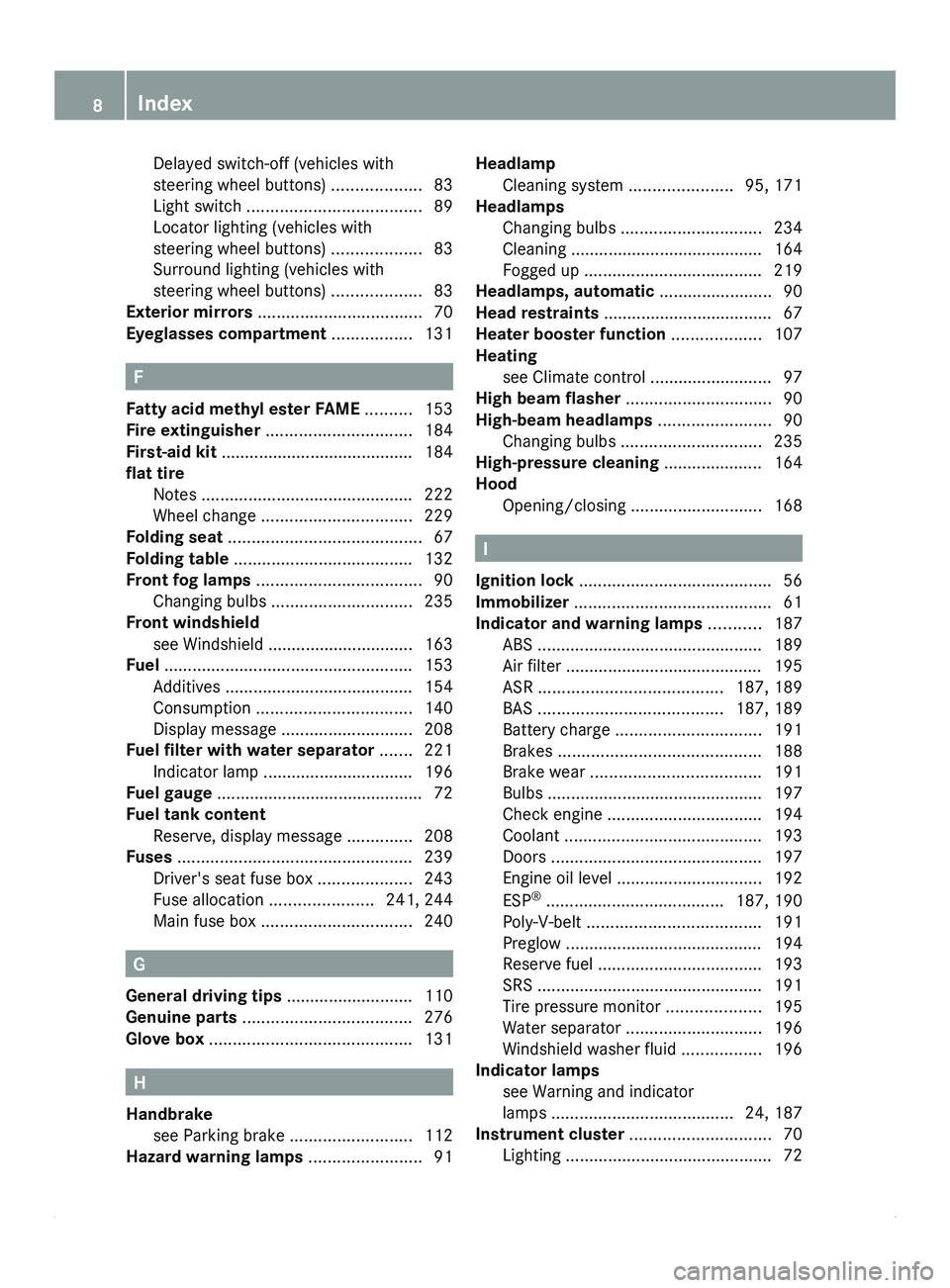
Delayed switch-off (vehicles with
steering wheel buttons) ...................
83
Light switch ..................................... 89
Locator lighting (vehicles with
steering wheel buttons) ................... 83
Surround lighting (vehicles with
steering wheel buttons) ................... 83
Exterior mirrors ................................... 70
Eyeglasses compartment ................. 131F
Fatty acid methyl ester FAME .......... 153
Fire extinguisher ............................... 184
First-aid kit .........................................
184
flat tire Notes ............................................. 222
Wheel change ................................ 229
Folding seat
......................................... 67
Folding table ...................................... 132
Front fog lamps ................................... 90
Changing bulbs .............................. 235
Front windshield
see Windshield ............................... 163
Fuel ..................................................... 153
Additives ........................................ 154
Consumption ................................. 140
Display message ............................ 208
Fuel filter with water separator .......221
Indicator lamp ................................ 196
Fuel gauge ............................................ 72
Fuel tank content Reserve, display message ..............208
Fuses .................................................. 239
Driver's seat fuse box .................... 243
Fuse allocation ...................... 241, 244
Main fuse box ................................ 240G
General driving tips ........................... 110
Genuine parts
.................................... 276
Glove box ........................................... 131H
Handbrake see Parking brake .......................... 112
Hazard warning lamps ........................91Headlamp
Cleaning system ......................95, 171
Headlamps
Changing bulbs .............................. 234
Cleaning ......................................... 164
Fogged up ...................................... 219
Headlamps, automatic
........................90
Head restraints .................................... 67
Heater booster function ...................107
Heating see Climate control .......................... 97
High beam flasher ............................... 90
High-beam headlamps ........................90
Changing bulbs .............................. 235
High-pressure cleaning ..................... 164
Hood Opening/closing ............................ 168 I
Ignition lock ......................................... 56
Immobilizer .......................................... 61
Indicator and warning lamps ........... 187
ABS ................................................ 189
Air filter ..........................................
195
ASR ....................................... 187, 189
BAS ....................................... 187, 189
Battery charge ............................... 191
Brakes ........................................... 188
Brake wear .................................... 191
Bulbs .............................................. 197
Check engine ................................. 194
Coolant .......................................... 193
Doors ............................................. 197
Engine oil level ............................... 192
ESP ®
...................................... 187, 190
Poly-V-belt ..................................... 191
Preglow .......................................... 194
Reserve fuel ................................... 193
SRS ................................................ 191
Tire pressure monitor .................... 195
Water separator ............................. 196
Windshield washer fluid ................. 196
Indicator lamps
see Warning and indicator
lamps ....................................... 24, 187
Instrument cluster .............................. 70
Lighting ............................................ 728
Index
Page 15 of 292
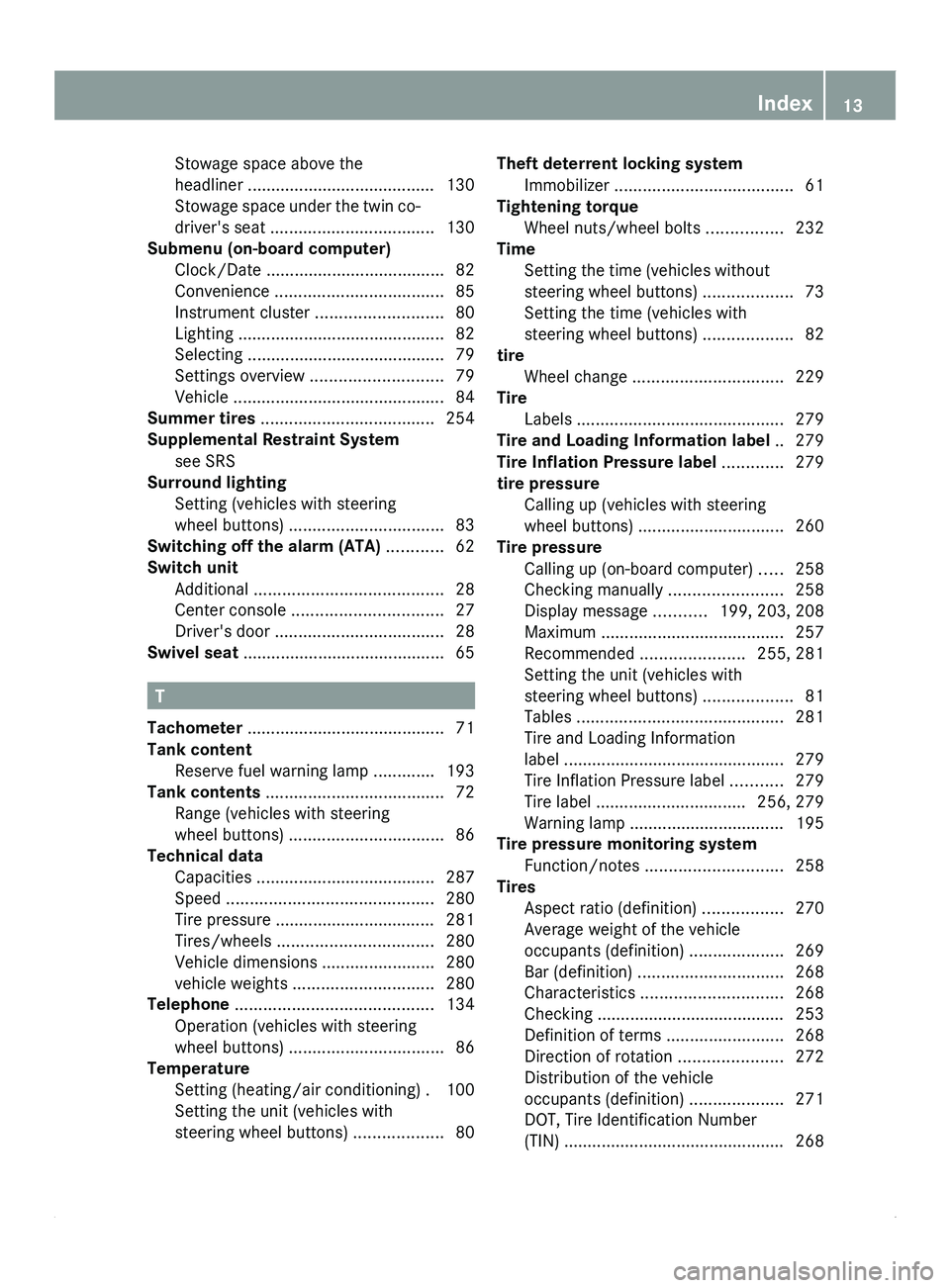
Stowage space above the
headliner ........................................ 130
Stowage
space
under the twin co-
driver's seat ................................... 130
Submenu (on-board computer)
Clock/Date ...................................... 82
Convenience .................................... 85
Instrument cluster ........................... 80
Lighting ............................................ 82
Selecting .......................................... 79
Settings overview ............................ 79
Vehicle ............................................. 84
Summer tires ..................................... 254
Supplemental Restraint System see SRS
Surround lighting
Setting (vehicles with steering
wheel buttons) ................................. 83
Switching off the alarm (ATA) ............62
Switch unit Additional ........................................ 28
Center console ................................ 27
Driver's door .................................... 28
Swivel seat ........................................... 65T
Tachometer .......................................... 71
Tank content Reserve fuel warning lamp ............. 193
Tank contents
...................................... 72
Range (vehicles with steering
wheel buttons) ................................. 86
Technical data
Capacities ...................................... 287
Speed ............................................ 280
Tire pressure .................................. 281
Tires/wheels ................................. 280
Vehicle dimensions ........................280
vehicle weights .............................. 280
Telephone .......................................... 134
Operation (vehicles with steering
wheel buttons) ................................. 86
Temperature
Setting (heating/air conditioning) . 100
Setting the unit (vehicles with
steering wheel buttons) ................... 80Theft deterrent locking system
Immobilizer ...................................... 61
Tightening torque
Wheel nuts/wheel bolts ................ 232
Time
Setting
the time (vehicles without
steering wheel buttons) ................... 73
Setting the time (vehicles with
steering wheel buttons) ................... 82
tire
Wheel change ................................ 229
Tire
Labels ............................................ 279
Tire and Loading Information label .. 279
Tire Inflation Pressure label .............279
tire pressure Calling up (vehicles with steering
wheel buttons) ............................... 260
Tire pressure
Calling up (on-board computer) ..... 258
Checking manually ........................258
Display message ...........199, 203, 208
Maximum ....................................... 257
Recommended ...................... 255, 281
Setting the unit (vehicles with
steering wheel buttons) ................... 81
Tables ............................................ 281
Tire and Loading Information
label ............................................... 279
Tire Inflation Pressure label ...........279
Tire label ................................ 256, 279
Warning lamp ................................. 195
Tire pressure monitoring system
Function/notes ............................. 258
Tires
Aspect ratio (definition) ................. 270
Average weight of the vehicle
occupants (definition) .................... 269
Bar (definition) ............................... 268
Characteristics .............................. 268
Checking ........................................ 253
Definition of terms ......................... 268
Direction of rotation ......................272
Distribution of the vehicle
occupants (definition) .................... 271
DOT, Tire Identification Number
(TIN) ............................................... 268 Index
13
Page 18 of 292
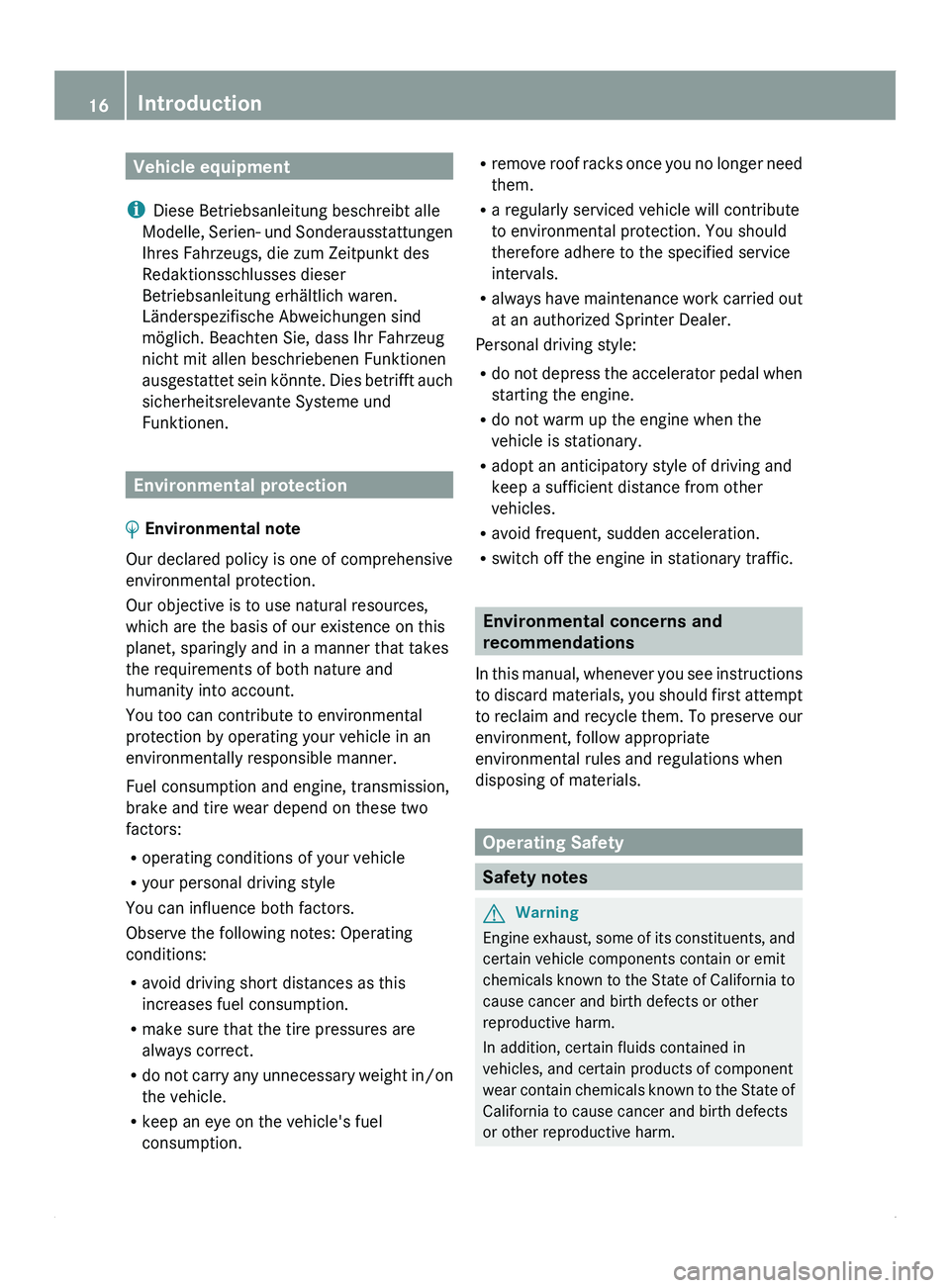
Vehicle equipment
i Diese Betriebsanleitung beschreibt alle
Modelle, Serien- und
Sonderausstattungen
Ihres Fahrzeugs, die zum Zeitpunkt des
Redaktionsschlusses dieser
Betriebsanleitung erhältlich waren.
Länderspezifische Abweichungen sind
möglich. Beachten Sie, dass Ihr Fahrzeug
nicht mit allen beschriebenen Funktionen
ausgestattet sein könnte. Dies betrifft auch
sicherheitsrelevante Systeme und
Funktionen. Environmental protection
0040
Environmental note
Our declared policy is one of comprehensive
environmental protection.
Our objective is to use natural resources,
which are the basis of our existence on this
planet, sparingly and in a manner that takes
the requirements of both nature and
humanity into account.
You too can contribute to environmental
protection by operating your vehicle in an
environmentally responsible manner.
Fuel consumption and engine, transmission,
brake and tire wear depend on these two
factors:
R operating conditions of your vehicle
R your personal driving style
You can influence both factors.
Observe the following notes: Operating
conditions:
R avoid driving short distances as this
increases fuel consumption.
R make sure that the tire pressures are
always correct.
R do not carry
any unnecessary weight in/on
the vehicle.
R keep an eye on the vehicle's fuel
consumption. R
remove roof racks
once you no longer need
them.
R a regularly serviced vehicle will contribute
to environmental protection. You should
therefore adhere to the specified service
intervals.
R always have maintenance work carried out
at an authorized Sprinter Dealer.
Personal driving style:
R do not depress the accelerator pedal when
starting the engine.
R do not warm up the engine when the
vehicle is stationary.
R adopt an anticipatory style of driving and
keep a sufficient distance from other
vehicles.
R avoid frequent, sudden acceleration.
R switch off the engine in stationary traffic. Environmental concerns and
recommendations
In this manual,
whenever you see instructions
to discard materials, you should first attempt
to reclaim and recycle them. To preserve our
environment, follow appropriate
environmental rules and regulations when
disposing of materials. Operating Safety
Safety notes
G
Warning
Engine exhaust,
some of its constituents, and
certain vehicle components contain or emit
chemicals known to
the State of California to
cause cancer and birth defects or other
reproductive harm.
In addition, certain fluids contained in
vehicles, and certain products of component
wear contain chemicals known to the State of
California to cause cancer and birth defects
or other reproductive harm. 16
Introduction
Page 27 of 292
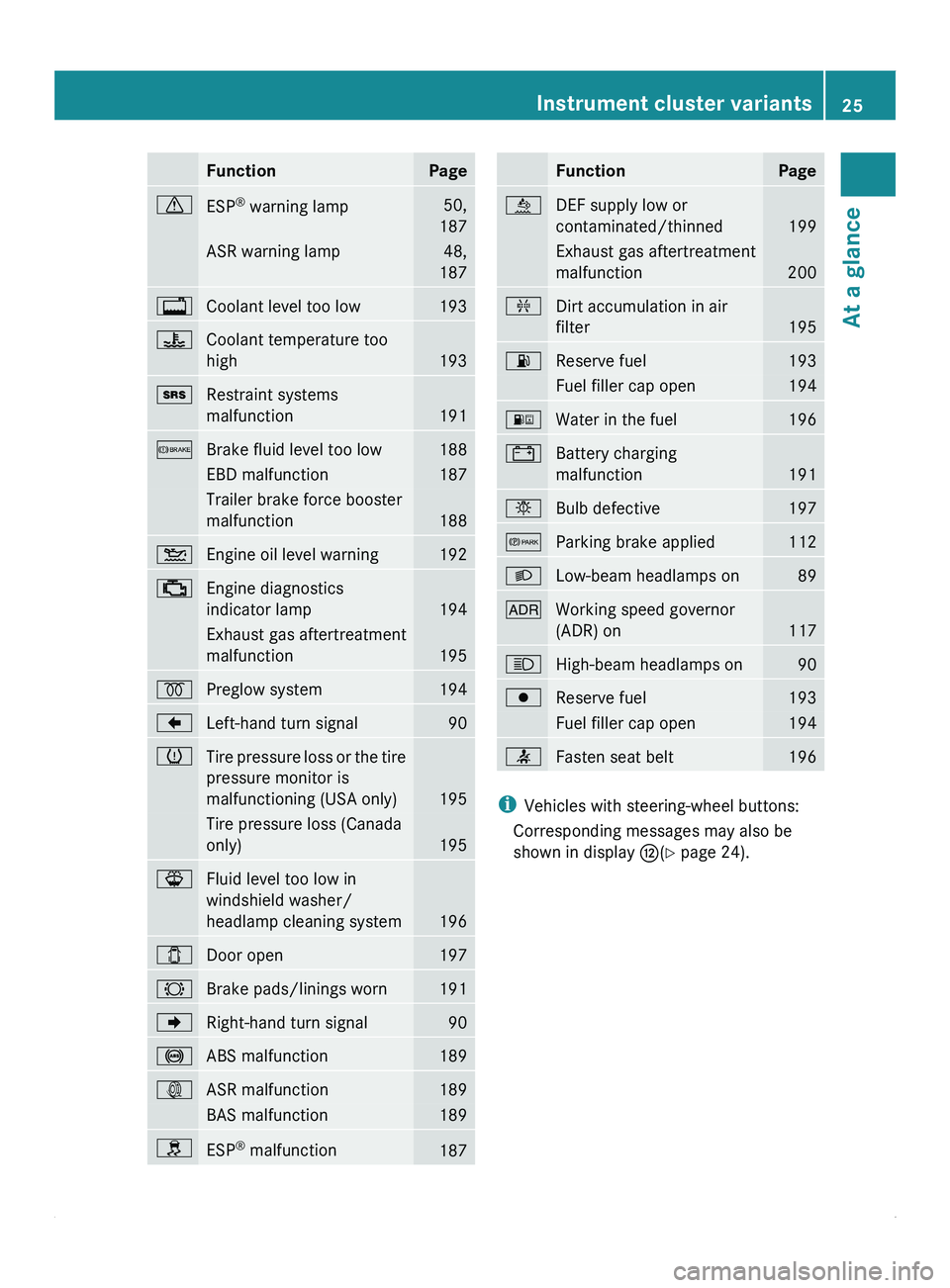
Function Page
0067
ESP
®
warning lamp 50,
187 ASR warning lamp 48,
187 0041
Coolant level too low 193
00AE
Coolant temperature too
high
193
008A
Restraint systems
malfunction
191
0065
Brake fluid level too low 188
EBD malfunction 187
Trailer brake force booster
malfunction
188
00B4
Engine oil level warning 192
00BB
Engine diagnostics
indicator lamp
194
Exhaust gas aftertreatment
malfunction
195
0028
Preglow system 194
004A
Left-hand turn signal 90
0077
Tire pressure loss or the tire
pressure monitor is
malfunctioning (USA only)
195
Tire pressure loss (Canada
only)
195
00BD
Fluid level too low in
windshield washer/
headlamp cleaning system
196
003E
Door open 197
0026
Brake pads/linings worn 191
004D
Right-hand turn signal 90
0031
ABS malfunction 189
003D
ASR malfunction 189
BAS malfunction 189
009E
ESP
®
malfunction 187 Function Page
00E4
DEF supply low or
contaminated/thinned
199
Exhaust gas aftertreatment
malfunction
200
00AB
Dirt accumulation in air
filter
195
00B6
Reserve fuel 193
Fuel filler cap open 194
00BA
Water in the fuel 196
003F
Battery charging
malfunction
191
0055
Bulb defective 197
0066
Parking brake applied 112
0064
Low-beam headlamps on 89
004E
Working speed governor
(ADR) on
117
0063
High-beam headlamps on 90
0080
Reserve fuel 193
Fuel filler cap open 194
0082
Fasten seat belt 196
i
Vehicles with steering-wheel buttons:
Corresponding messages may also be
shown in display 0073(Y page 24). Instrument cluster variants
25At a glance
Page 75 of 292
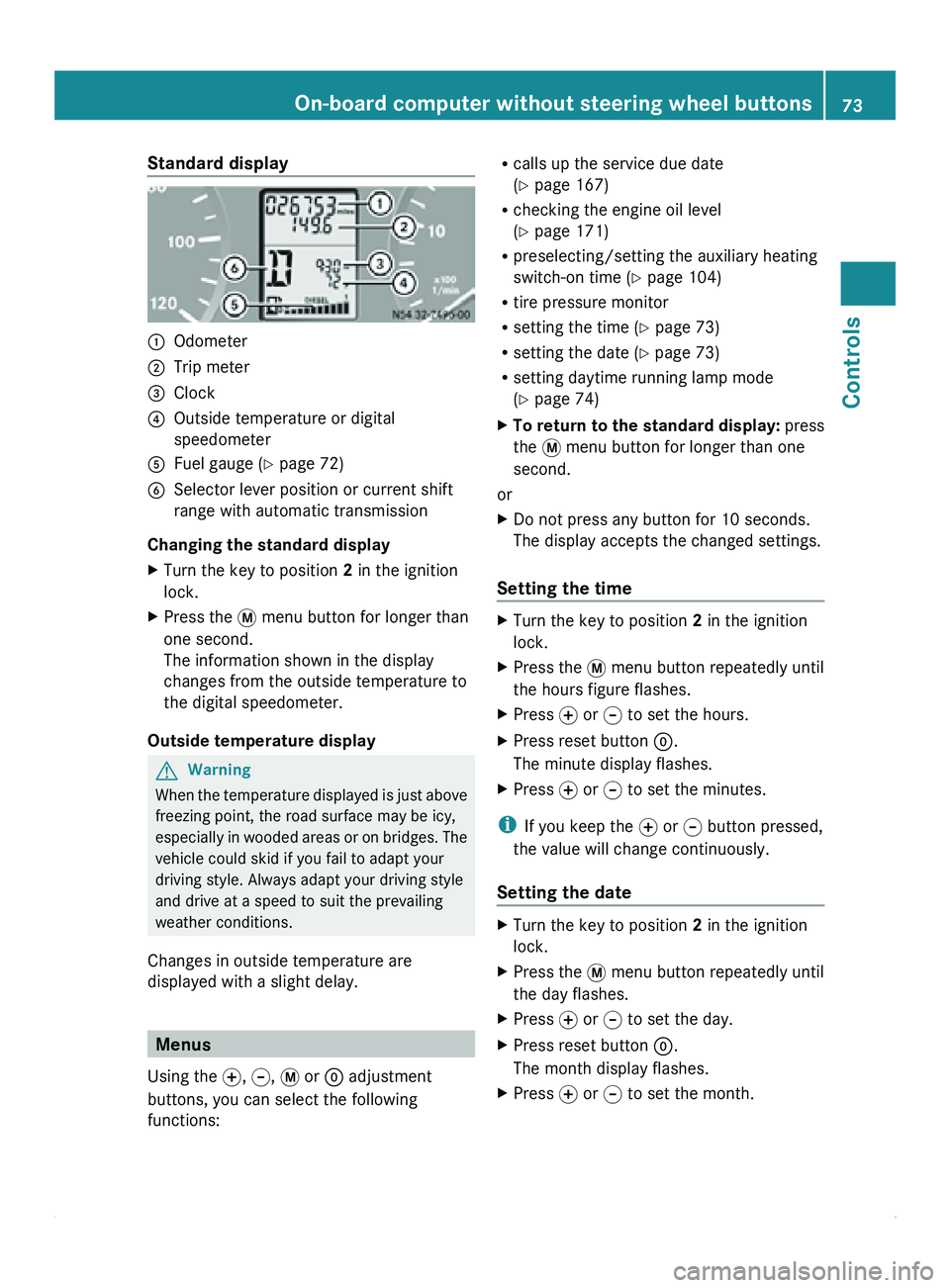
Standard display
0046
Odometer
0047 Trip meter
008A Clock
0088 Outside temperature or digital
speedometer
0086 Fuel gauge ( Y page 72)
0087 Selector lever position or current shift
range with automatic transmission
Changing the standard display
X Turn the key to position 2 in the ignition
lock.
X Press the 007B menu button for longer than
one second.
The information shown in the display
changes from the outside temperature to
the digital speedometer.
Outside temperature display G
Warning
When the temperature displayed is just above
freezing point, the road surface may be icy,
especially in wooded
areas or on bridges. The
vehicle could skid if you fail to adapt your
driving style. Always adapt your driving style
and drive at a speed to suit the prevailing
weather conditions.
Changes in outside temperature are
displayed with a slight delay. Menus
Using the 0069, 006A, 007B or 0048 adjustment
buttons, you can select the following
functions: R
calls up the service due date
(Y page 167)
R checking the engine oil level
(Y page 171)
R preselecting/setting the auxiliary heating
switch-on time ( Y page 104)
R tire pressure monitor
R setting the time (Y
page 73)
R setting the date ( Y page 73)
R setting daytime running lamp mode
(Y page 74)
X To return to the standard display: press
the 007B menu button for longer than one
second.
or
X Do not press any button for 10 seconds.
The display accepts the changed settings.
Setting the time X
Turn the key to position 2 in the ignition
lock.
X Press the 007B menu button repeatedly until
the hours figure flashes.
X Press 0069 or 006A to set the hours.
X Press reset button 0048.
The minute display flashes.
X Press 0069 or 006A to set the minutes.
i If you keep the 0069 or 006A button pressed,
the value will change continuously.
Setting the date X
Turn the key to position 2 in the ignition
lock.
X Press the 007B menu button repeatedly until
the day flashes.
X Press 0069 or 006A to set the day.
X Press reset button 0048.
The month display flashes.
X Press 0069 or 006A to set the month. On-board computer without steering wheel buttons
73
Controls Z
Page 140 of 292
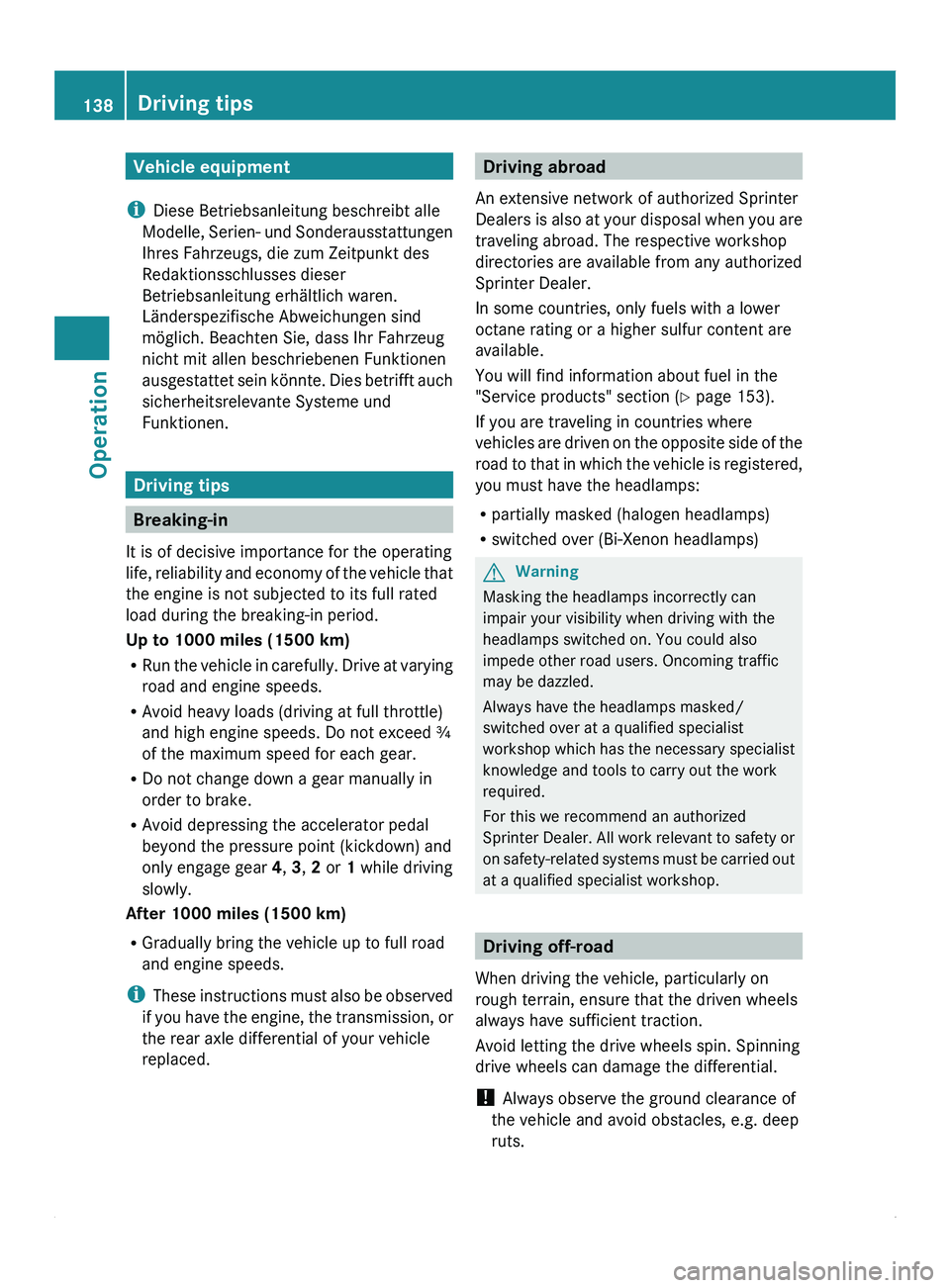
Vehicle equipment
i Diese Betriebsanleitung beschreibt alle
Modelle, Serien- und
Sonderausstattungen
Ihres Fahrzeugs, die zum Zeitpunkt des
Redaktionsschlusses dieser
Betriebsanleitung erhältlich waren.
Länderspezifische Abweichungen sind
möglich. Beachten Sie, dass Ihr Fahrzeug
nicht mit allen beschriebenen Funktionen
ausgestattet sein könnte. Dies betrifft auch
sicherheitsrelevante Systeme und
Funktionen. Driving tips
Breaking-in
It is of decisive importance for the operating
life, reliability and
economy of the vehicle that
the engine is not subjected to its full rated
load during the breaking-in period.
Up to 1000 miles (1500 km)
R Run the vehicle in carefully. Drive at varying
road and engine speeds.
R Avoid heavy loads (driving at full throttle)
and high engine speeds. Do not exceed ¾
of the maximum speed for each gear.
R Do not change down a gear manually in
order to brake.
R Avoid depressing the accelerator pedal
beyond the pressure point (kickdown) and
only engage gear 4, 3, 2 or 1 while driving
slowly.
After 1000 miles (1500 km)
R Gradually bring the vehicle up to full road
and engine speeds.
i These instructions must also be observed
if you have the engine, the transmission, or
the rear axle differential of your vehicle
replaced. Driving abroad
An extensive network of authorized Sprinter
Dealers is also
at your disposal when you are
traveling abroad. The respective workshop
directories are available from any authorized
Sprinter Dealer.
In some countries, only fuels with a lower
octane rating or a higher sulfur content are
available.
You will find information about fuel in the
"Service products" section (Y page 153).
If you are traveling in countries where
vehicles are driven on the opposite side of the
road to that in which the vehicle is registered,
you must have the headlamps:
R partially masked (halogen headlamps)
R switched over (Bi-Xenon headlamps) G
Warning
Masking the headlamps incorrectly can
impair your visibility when driving with the
headlamps switched on. You could also
impede other road users. Oncoming traffic
may be dazzled.
Always have the headlamps masked/
switched over at a qualified specialist
workshop which has
the necessary specialist
knowledge and tools to carry out the work
required.
For this we recommend an authorized
Sprinter Dealer. All work relevant to safety or
on safety-related systems must be carried out
at a qualified specialist workshop. Driving off-road
When driving the vehicle, particularly on
rough terrain, ensure that the driven wheels
always have sufficient traction.
Avoid letting the drive wheels spin. Spinning
drive wheels can damage the differential.
! Always observe the ground clearance of
the vehicle and avoid obstacles, e.g. deep
ruts. 138
Driving tips
Operation
Page 142 of 292
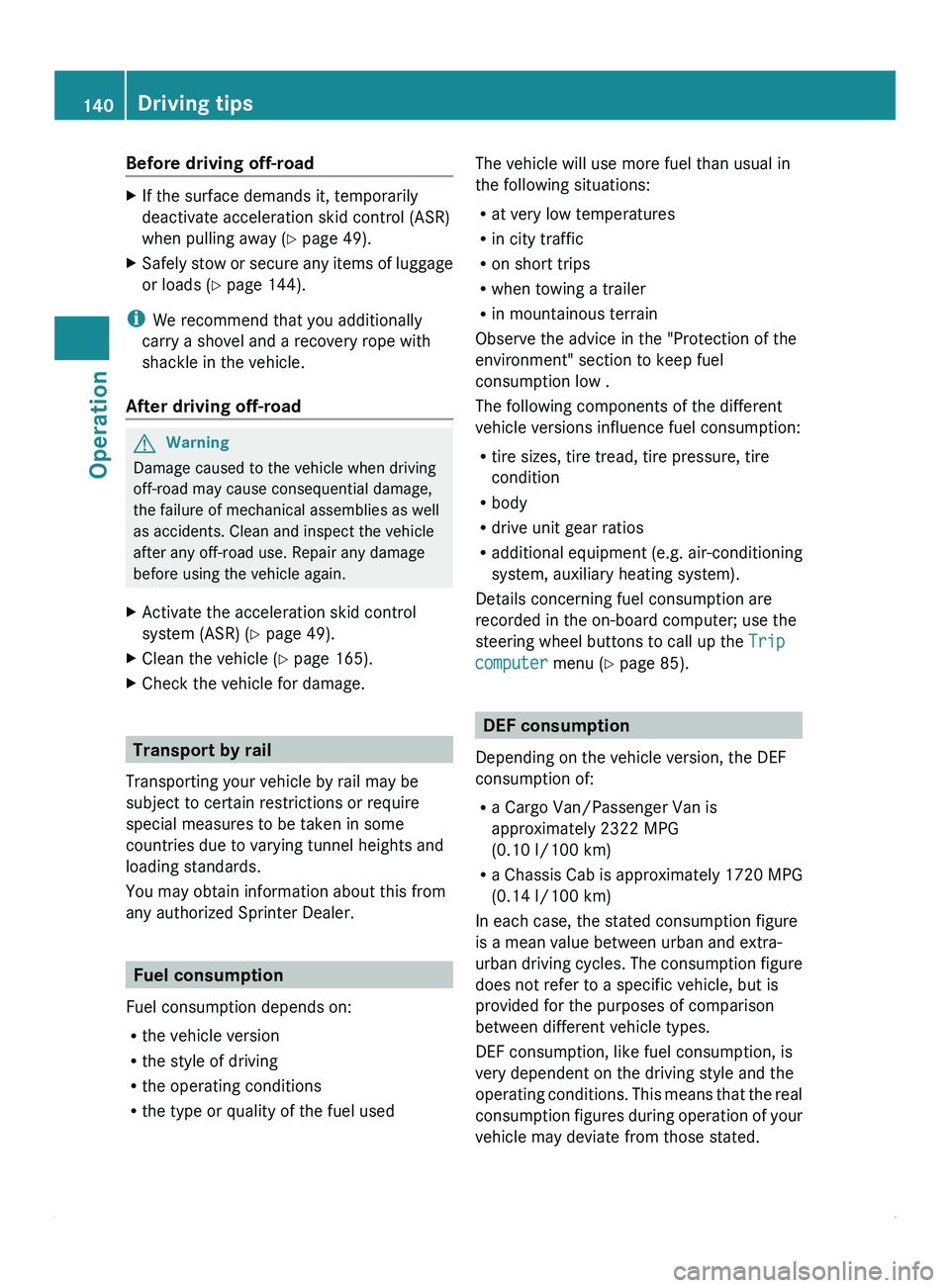
Before driving off-road
X
If the surface demands it, temporarily
deactivate acceleration skid control (ASR)
when pulling away ( Y
page 49).
X Safely stow or secure any items of luggage
or loads ( Y page 144).
i We recommend that you additionally
carry a shovel and a recovery rope with
shackle in the vehicle.
After driving off-road G
Warning
Damage caused to the vehicle when driving
off-road may cause consequential damage,
the failure of mechanical assemblies as well
as accidents. Clean and inspect the vehicle
after any off-road use. Repair any damage
before using the vehicle again.
X Activate the acceleration skid control
system (ASR) ( Y page 49).
X Clean the vehicle (Y page 165).
X Check the vehicle for damage. Transport by rail
Transporting your vehicle by rail may be
subject to certain restrictions or require
special measures to be taken in some
countries due to varying tunnel heights and
loading standards.
You may obtain information about this from
any authorized Sprinter Dealer. Fuel consumption
Fuel consumption depends on:
R the vehicle version
R the style of driving
R the operating conditions
R the type or quality of the fuel used The vehicle will use more fuel than usual in
the following situations:
R
at very low temperatures
R in city traffic
R on short trips
R when towing a trailer
R in mountainous terrain
Observe the advice in the "Protection of the
environment" section to keep fuel
consumption low .
The following components of the different
vehicle versions influence fuel consumption:
R tire sizes, tire tread, tire pressure, tire
condition
R body
R drive unit gear ratios
R additional equipment (e.g. air-conditioning
system, auxiliary heating system).
Details concerning fuel consumption are
recorded in the on-board computer; use the
steering wheel buttons to call up the Trip
computer menu (Y page 85). DEF consumption
Depending on the vehicle version, the DEF
consumption of:
R a Cargo Van/Passenger Van is
approximately 2322 MPG
(0.10 l/100 km)
R a Chassis Cab
is approximately 1720 MPG
(0.14 l/100 km)
In each case, the stated consumption figure
is a mean value between urban and extra-
urban driving cycles. The consumption figure
does not refer to a specific vehicle, but is
provided for the purposes of comparison
between different vehicle types.
DEF consumption, like fuel consumption, is
very dependent on the driving style and the
operating conditions. This means that the real
consumption figures during operation of your
vehicle may deviate from those stated. 140
Driving tips
Operation
Page 143 of 292
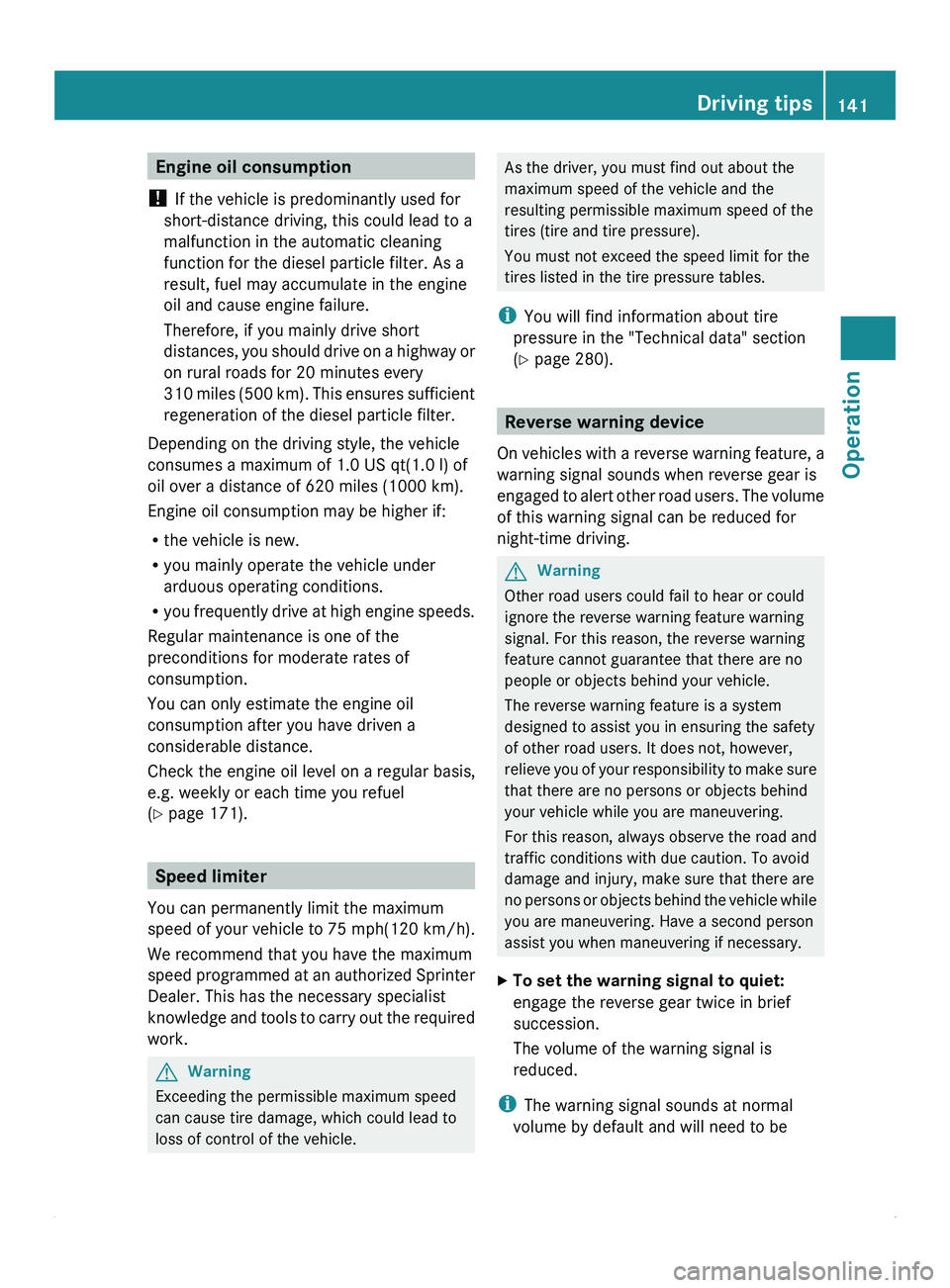
Engine oil consumption
! If the vehicle is predominantly used for
short-distance driving, this could lead to a
malfunction in the automatic cleaning
function for the diesel particle filter. As a
result, fuel may accumulate in the engine
oil and cause engine failure.
Therefore, if you mainly drive short
distances, you should
drive on a highway or
on rural roads for 20 minutes every
310 miles (500 km). This ensures sufficient
regeneration of the diesel particle filter.
Depending on the driving style, the vehicle
consumes a maximum of 1.0 US qt(1.0 l) of
oil over a distance of 620 miles (1000 km).
Engine oil consumption may be higher if:
R the vehicle is new.
R you mainly operate the vehicle under
arduous operating conditions.
R you frequently drive at high engine speeds.
Regular maintenance is one of the
preconditions for moderate rates of
consumption.
You can only estimate the engine oil
consumption after you have driven a
considerable distance.
Check the engine oil level on a regular basis,
e.g. weekly or each time you refuel
(Y page 171). Speed limiter
You can permanently limit the maximum
speed of your vehicle to 75 mph (120 km/h)
.
We recommend that you have the maximum
speed programmed at an authorized Sprinter
Dealer. This has the necessary specialist
knowledge and tools to carry out the required
work. G
Warning
Exceeding the permissible maximum speed
can cause tire damage, which could lead to
loss of control of the vehicle. As the driver, you must find out about the
maximum speed of the vehicle and the
resulting permissible maximum speed of the
tires (tire and tire pressure).
You must not exceed the speed limit for the
tires listed in the tire pressure tables.
i You will find information about tire
pressure in the "Technical data" section
(Y
page 280).
Reverse warning device
On vehicles with
a reverse warning feature, a
warning signal sounds when reverse gear is
engaged to alert other road users. The volume
of this warning signal can be reduced for
night-time driving. G
Warning
Other road users could fail to hear or could
ignore the reverse warning feature warning
signal. For this reason, the reverse warning
feature cannot guarantee that there are no
people or objects behind your vehicle.
The reverse warning feature is a system
designed to assist you in ensuring the safety
of other road users. It does not, however,
relieve you of
your responsibility to make sure
that there are no persons or objects behind
your vehicle while you are maneuvering.
For this reason, always observe the road and
traffic conditions with due caution. To avoid
damage and injury, make sure that there are
no persons or objects behind the vehicle while
you are maneuvering. Have a second person
assist you when maneuvering if necessary.
X To set the warning signal to quiet:
engage the reverse gear twice in brief
succession.
The volume of the warning signal is
reduced.
i The warning signal sounds at normal
volume by default and will need to be Driving tips
141
Operation Z
Page 165 of 292
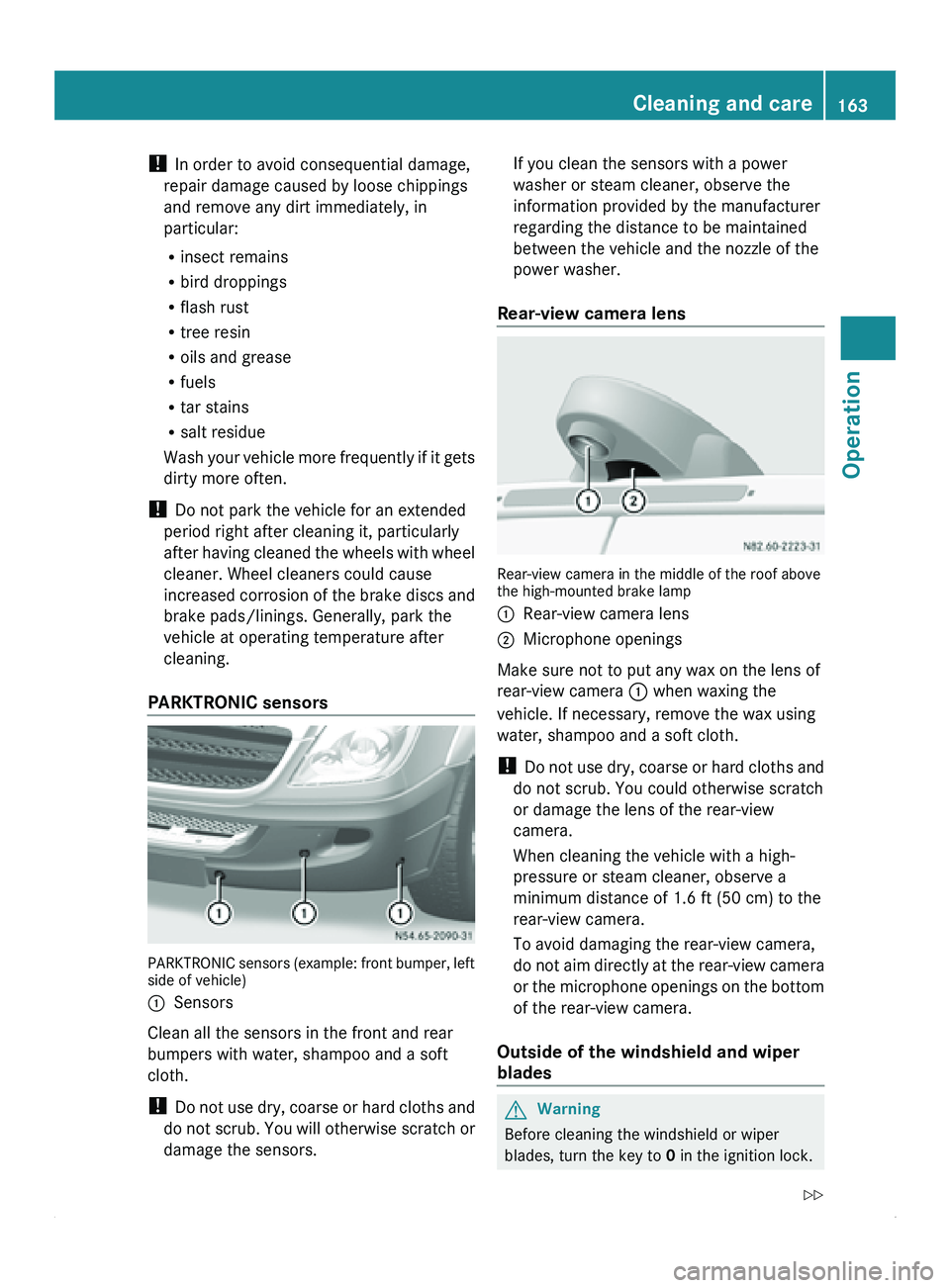
!
In order to avoid consequential damage,
repair damage caused by loose chippings
and remove any dirt immediately, in
particular:
R insect remains
R bird droppings
R flash rust
R tree resin
R oils and grease
R fuels
R tar stains
R salt residue
Wash your vehicle
more frequently if it gets
dirty more often.
! Do not park the vehicle for an extended
period right after cleaning it, particularly
after having cleaned the wheels with wheel
cleaner. Wheel cleaners could cause
increased corrosion of the brake discs and
brake pads/linings. Generally, park the
vehicle at operating temperature after
cleaning.
PARKTRONIC sensors PARKTRONIC sensors (example: front bumper, left
side of vehicle)
0046
Sensors
Clean all the sensors in the front and rear
bumpers with water, shampoo and a soft
cloth.
! Do not
use
dry, coarse or hard cloths and
do not scrub. You will otherwise scratch or
damage the sensors. If you clean the sensors with a power
washer or steam cleaner, observe the
information provided by the manufacturer
regarding the distance to be maintained
between the vehicle and the nozzle of the
power washer.
Rear-view camera lens Rear-view camera in the middle of the roof above
the high-mounted brake lamp
0046
Rear-view camera lens
0047 Microphone openings
Make sure not to put any wax on the lens of
rear-view camera 0046 when waxing the
vehicle. If necessary, remove the wax using
water, shampoo and a soft cloth.
! Do not
use
dry, coarse or hard cloths and
do not scrub. You could otherwise scratch
or damage the lens of the rear-view
camera.
When cleaning the vehicle with a high-
pressure or steam cleaner, observe a
minimum distance of 1.6 ft (50 cm) to the
rear-view camera.
To avoid damaging the rear-view camera,
do not aim directly at the rear-view camera
or the microphone openings on the bottom
of the rear-view camera.
Outside of the windshield and wiper
blades G
Warning
Before cleaning the windshield or wiper
blades, turn the key to 0 in the ignition lock. Cleaning and care
163
Operation
Z
Page 172 of 292
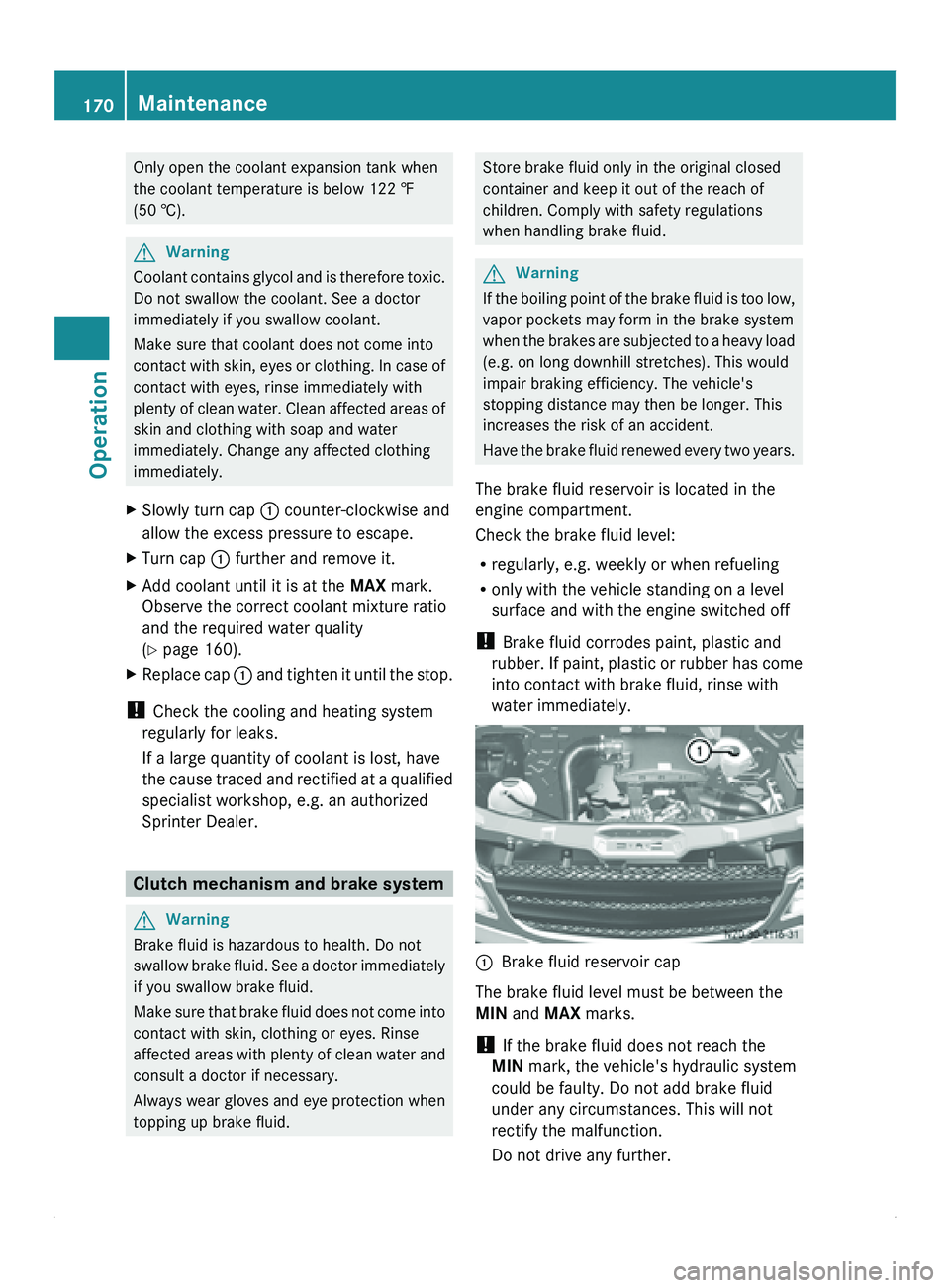
Only open the coolant expansion tank when
the coolant temperature is below 122 ‡
(50 †).
G
Warning
Coolant contains glycol and is therefore toxic.
Do not swallow the coolant. See a doctor
immediately if you swallow coolant.
Make sure that coolant does not come into
contact with skin,
eyes or clothing. In case of
contact with eyes, rinse immediately with
plenty of clean water. Clean affected areas of
skin and clothing with soap and water
immediately. Change any affected clothing
immediately.
X Slowly turn cap 0046 counter-clockwise and
allow the excess pressure to escape.
X Turn cap 0046 further and remove it.
X Add coolant until it is at the MAX mark.
Observe the correct coolant mixture ratio
and the required water quality
(Y page 160).
X Replace cap 0046 and tighten
it until the stop.
! Check the cooling and heating system
regularly for leaks.
If a large quantity of coolant is lost, have
the cause traced
and rectified at a qualified
specialist workshop, e.g. an authorized
Sprinter Dealer. Clutch mechanism and brake system
G
Warning
Brake fluid is hazardous to health. Do not
swallow brake fluid.
See a doctor immediately
if you swallow brake fluid.
Make sure that brake fluid does not come into
contact with skin, clothing or eyes. Rinse
affected areas with plenty of clean water and
consult a doctor if necessary.
Always wear gloves and eye protection when
topping up brake fluid. Store brake fluid only in the original closed
container and keep it out of the reach of
children. Comply with safety regulations
when handling brake fluid.
G
Warning
If the
boiling point of the brake fluid is too low,
vapor pockets may form in the brake system
when the brakes
are subjected to a heavy load
(e.g. on long downhill stretches). This would
impair braking efficiency. The vehicle's
stopping distance may then be longer. This
increases the risk of an accident.
Have the brake fluid renewed every two years.
The brake fluid reservoir is located in the
engine compartment.
Check the brake fluid level:
R regularly, e.g. weekly or when refueling
R only with the vehicle standing on a level
surface and with the engine switched off
! Brake fluid corrodes paint, plastic and
rubber. If paint, plastic or rubber has come
into contact with brake fluid, rinse with
water immediately. 0046
Brake fluid reservoir cap
The brake fluid level must be between the
MIN and
MAX marks.
! If the brake fluid does not reach the
MIN mark, the vehicle's hydraulic system
could be faulty. Do not add brake fluid
under any circumstances. This will not
rectify the malfunction.
Do not drive any further. 170
Maintenance
Operation